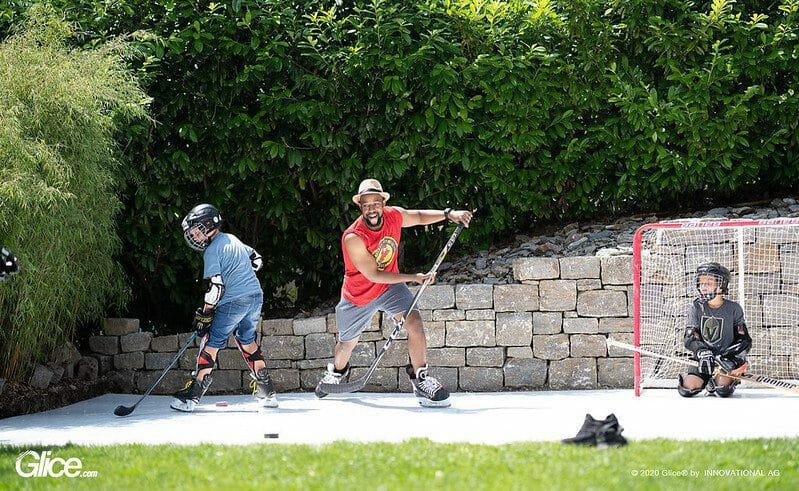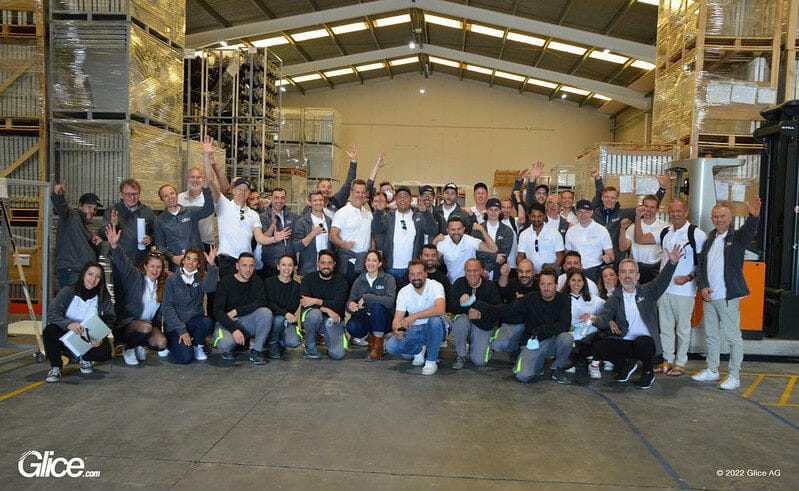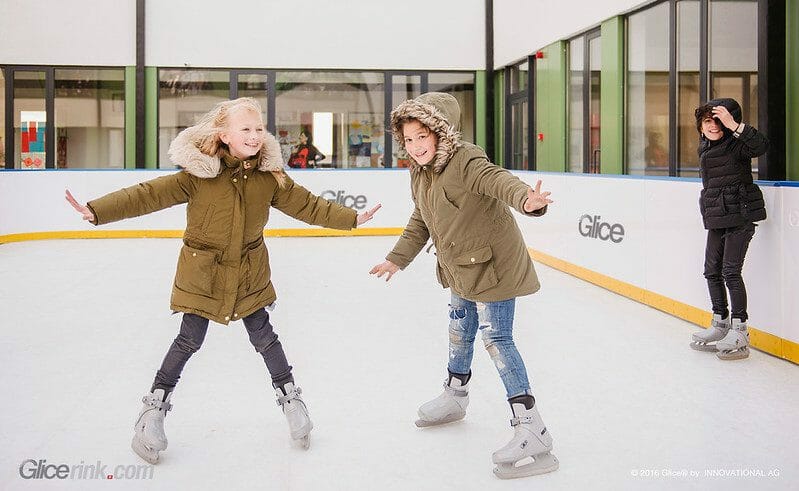Synthetic ice has become increasingly more mainstream over the last couple of decades. Factors such as the high cost of maintenance and environmental impact are driving the growing popularity of plastic ice rinks. More and more municipalities, hockey clubs, leisure operators and even individual consumers are opting for synthetic ice as a cost-effective and sustainable alternative to real ice.
But, is artificial ice any good? And what are the main differences when comparing synthetic ice to real ice?
Let’s look at the overall skating experience of synthetic ice, and how it comes out in front when compared to real ice when considering environmental factors, maintenance, operating costs, and more.
What Is the Difference Between Synthetic Ice and Real Ice?
What is synthetic ice? Obviously it has its differences when compared to real ice, but is it the same as plastic or artificial ice?
In a nutshell, synthetic ice is a form of plastic ice that’s used to replace real ice for skating. Rather than freezing water to create a skatable surface, it is made from high-density polymer (polyethene plastic). Artificial ice, on the other hand, has a dual meaning. It can refer to ice that’s created by freezing water through human intervention, or it can also be used as another name for synthetic ice.
Moving past the obvious difference in synthetic ice and real ice—being the material they are made of—when comparing the two it is important to consider the:
- Skating experience
- Surfaces
- Maintenance
- Cost
- Environmental impact
Skating Experience: The Glide Effect
Matching the glide effect of real ice has always been a big challenge for the synthetic ice industry. The reason? Friction.
Low-quality synthetic ice can cause friction, leading to an undesirable skating experience and dull skates. Even the slightest amount of friction will disrupt a skater’s flow. It also makes gliding difficult and requires more effort. Athletes waste indispensable energy and for recreational skaters, the experience becomes less enjoyable.
While many synthetic ice rinks incorporate new technologies to make skating as easy and pleasant as possible, a lot of plastic ice rinks simply aren’t able to provide an ice-like feeling on their synthetic ice.
For synthetic ice to compete it must not only use quality materials and the newest technology, but also create an ice-like response. Only then can skaters skate to the fullest. It’s not just about gliding and speed, it’s about the feeling and the relationship the skater creates with the ice.
Today’s self-lubricating premium products offer a glide effect that is very similar to conventional ice. Moreover, they allow for authentically replicating any biometric movements made when skating.
That’s why even top league hockey clubs and professional figure skaters are now using waterless alternatives for their practice sessions. Don’t take our word for it—read through the testimonials we’ve received from athletes and customers worldwide about their performance on Glice synthetic ice.
7 Benefits of Synthetic Ice
There’s no denying that a traditional ice rink offers a more natural ice surface. It is the real thing after all. However, traditional ice rinks also come with a host of insignificant disadvantages that include everything from exorbitant electricity costs and environmental implications to the time it takes for maintenance and general upkeep.
Conversely, synthetic ice offers numerous benefits that make it the preferable option in most scenarios. That’s not to say it’s without challenges, but properly approached they can be fairly easily overcome.
1. Synthetic Ice Is a Lot More Versatile
Due to its frozen nature, real ice is only feasible in cold winter climates. Synthetic ice is completely independent of climate conditions and can be installed throughout the year and worldwide—even in the tropics or in desert countries.
The fact that synthetic ice doesn’t need any refrigeration also makes it the perfect choice for venues where generator noise would be a disturbance. Plus, there’s the added bonus of not having to concern yourself with the cost of water and electricity.
2. Good for the Environment (As In, Really Good)
It’s no secret that real ice rinks are heavy on resources. They require an enormous amount of water and electricity to create a new layer of ice every few hours in order for skaters to enjoy optimal performance on a smooth ice sheet.
According to a study done by the University of McGill in Toronto, the winter season is shrinking. Some 55 years ago, Toronto skaters had about 75 days a year to skate outdoors on truly natural ice. Nowadays, that number is down to 60. If we don’t take care of our environment today, in another 55 years the damage might be irreparable.
Synthetic ice rinks not only eliminate the water and electricity costs, but they are also made from completely recyclable material and designed to be environmentally friendly. Going green and practicing your favorite sport has never been easier. At Glice, we pride ourselves on being a carbon-neutral company that plants one tree for every panel sold. Who doesn’t want to skate for the planet?
3. Accessible for Anyone, Anywhere, at Any Time
Contrary to conventional ice rinks, artificial or plastic ice rinks can be used anywhere, at any time. They are completely feasible for countries with warm or even tropical climates, and can be installed indoors as well as outside.
Along with reducing the cost and eliminating environmental implications, another driving factor of synthetic ice is accessibility. Ice hockey, curling, figure skating, and other winter sports can be a great platform for people from different social and economic backgrounds to come together and interact, creating a common base that really makes a difference in a community.
This concept is especially important for Glice. Having a positive impact on the people and communities we serve has (and always will be) a top priority for us.
4. Minimal Setup Time
 Setting up a conventional ice rink is a costly and complicated business with numerous moving parts and ongoing expenditures. (No wonder there aren’t that many privately owned ice rinks out there.)
Setting up a conventional ice rink is a costly and complicated business with numerous moving parts and ongoing expenditures. (No wonder there aren’t that many privately owned ice rinks out there.)
Real ice doesn’t last year round either. Most ice rinks have to be taken down come summer and then re-installed in the winter. This of course means a repetition of all the installation costs each year.
Synthetic ice offers an easy solution. The installation of an artificial ice rink takes noticeably less time. Depending on the size, most rinks can be installed within a day. Even uninstalling and packing them away (should the need ever arise) doesn’t take all that long.
Your plastic ice rink can be as big or as small as you like. And once it’s installed, all you have to do is put on your skates and hit the ice.
5. Reusable for Years to Come
Glice rinks are designed to be reused repeatedly. Depending on the thickness of the panels, they can last for many years. Provided, of course, that Glice’s maintenance guidelines are correctly followed. Taking good care of your synthetic rink isn’t hard though. Vacuum it daily, polish once or twice a week, and use skates with sharp blades, and your rink will easily last ten or more years!
6. Low Maintenance Costs
According to an article in the Washington Times, at least $4.8 million went to funding government-run ice rinks in the United States in 2014. Governments around the world run huge deficits to subsidize ice hockey, figure skating, and other winter sports, all in an attempt to maintain a competitive edge.
This is especially relevant for countries in warmer climate zones. The cost of water and electricity has skyrocketed over the years, making it nearly impossible to subsidize these sports.
Synthetic ice rinks offer a cost-effective and high-quality solution to this ever-growing problem. Good synthetic ice rinks are self-lubricating, and have UV-protection to preserve the chemical stability of the ice panels and avoid discoloration. Plus, there are no water or electricity bills to factor in.
7. Indoor/Outdoor Advantage
Another challenge with real ice rinks is choosing the right spot to install them. It has to be a big open space and it has to be outdoors. Synthetic ice rinks can be installed anywhere, at any time. If you want an ice rink in your basement, you can have it in your basement without having to worry about flooding the area when the ice melts. Same goes for a garage hockey rink.

5 Challenges of Synthetic Ice Rinks and How to Overcome Them
While synthetic ice has been around for a couple of decades now, there are still some challenges that ice rink creators must overcome to take their product to the next level.
1. Uneven Surface Due to Incorrect Interlocking System
 Most synthetic ice rinks use a puzzle or dovetail interlocking system, where the ice panels are interlocked horizontally, but not vertically. This can create a vertical shift in the panels, causing the ice sheets to be uneven. The longer puzzle connections also allow dirt or water to enter, resulting in an uneven surface and even shifting the ice panels.
Most synthetic ice rinks use a puzzle or dovetail interlocking system, where the ice panels are interlocked horizontally, but not vertically. This can create a vertical shift in the panels, causing the ice sheets to be uneven. The longer puzzle connections also allow dirt or water to enter, resulting in an uneven surface and even shifting the ice panels.
At Glice, we’ve overcome this issue by implementing a tongue and groove interlocking system (as shown in the picture). Because the panels can be interlocked horizontally and vertically, it’s impossible for them to shift in any direction. This creates a perfectly seamless surface that resembles real ice. This is especially important for outdoor rinks which are subject to constant thermal expansion and contraction.
2. High Amount of Shavings and Abrasion
Cheap synthetic ice causes abrasion and shavings, leaving behind a messy rink, unhappy skaters, and a sky-high cleaning bill. To avoid this, premium quality raw materials have to be used. Self-lubrication also adds to the quality of the ice sheet. This means that no chemicals need to be added to the ice panels to create a smooth surface.
However, this alone does not guarantee an exceptional performance. Everything, from the quality and grade of the raw materials to the manufacturing process and the formula by which components are added, all play a role in the quality of synthetic ice rinks.
3. Skate Blades Need to Be Sharpened Too Often
To avoid friction and dull blades you need Ultra Glide Technology with enhanced molecular structure. Most lower quality plastic ice rinks don’t incorporate this technology, making skating difficult and even frustrating.
Fortunately, there are synthetic ice rinks with ultra-glide technology that not only enhance the glide factor but also allow you to have a better grip, resembling that of real ice rinks, and providing the conditions for you to exploit your skating potential.
4. Unreliable Chemical Stability of Raw Materials
Premium quality is not a luxury. Shopping for cheaper ice rinks will not pay off. The price may be appealing, but the quality won’t. When exposed to sun, rain, and snow, it’s likely that a low-quality synthetic ice rink will change color over time. Its chemical stability will also vary.
In addition to UV-protection, good quality raw materials are of vital importance to ensure the endurance and unfading quality of synthetic ice. Spend the extra dollar and get a premium-quality rink that will not only last, but deliver on its promise to make the experience more enjoyable and your investment worthwhile!
5. Low-Quality Accessories
Low-quality accessories can quickly become the Achilles Heel of synthetic ice rinks. It doesn’t matter how seamless the surface of your synthetic ice rink is, if the dasher-boards are ugly or your skates are sub-par, it will have a negative impact. High quality, durable and compatible accessories make all the difference.
Why Is Glice the Best Synthetic Ice?
Synthetic ice is the way of the future, becoming more popular due to the significant advantages it offers over conventional ice.
Synthetic ice rinks can be utilized around the clock without the need for frequent resurfacing. Their gliding consistency surpasses that of natural ice, which deteriorates from 100% to 80% after only a short period of use. Additionally, they offer an eco-friendly and cost-effective alternative to their traditional counterparts, eliminating the exorbitant costs associated with water and electricity consumption.
However, these benefits are only made possible when the absolute best synthetic ice products are used.

Glice is renowned for installing rinks worldwide in locations that seemed impossible, from a rooftop in New York City to the desert in Dubai.
It is manufactured in a highly controlled factory (temperature, humidity, pressing forces, time, etc.) in Germany that produces only Glice products. Many other companies produce in shared facilities, typically in lower-cost locations or overseas.
Whether you are considering a synthetic ice rink for personal use in your backyard, or to provide shoppers in your mall some added entertainment, contact us today! Our experts will make sure you get all your questions answered and help you choose the right product for your needs.


